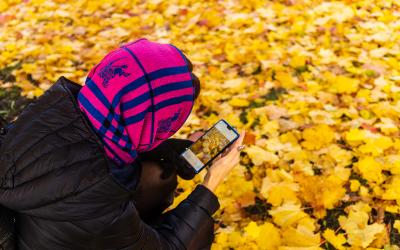Research to enable children to recreate textures found in nature on phones

An OU-led research project which will develop digital tools that will make it possible for children to recreate textures found in nature has been funded.
The Sensory Explorations of Nature in School Environments (SENSE) project, led by Professor Advaith Siddharthan and his team from the OU’s Knowledge Media Institute and EEES have received a share of £8 million from the Engineering and Physical Sciences Research Council (EPSRC), part of UK Research and Innovation (UKRI), to carry out this interdisciplinary research project, which begins in October 2021 and will run for three years.
This is one of 10 projects receiving funding to find sustainable digital solutions to pressing sustainability issues through the EPSRC Sustainable Digital Society call.
In collaboration with the University of Edinburgh, Imperial College London and Learning through Landscapes, Professor Siddharthan and his team have received just over £828,000 to develop a type of “haptic adaptor kit” that can be fitted to mobile phones or tablets to bring nature to the child through enabling the texture of say, a leaf or a feather, to be felt on the screen.
Recent analysis of the impacts of the COVID-19 outbreak on children has shown a critical link between low educational attainment and reduced access to nature and the outdoors for children living in poverty. The use of haptic technologies and its deployment in school grounds is aimed at helping foster greater interest in and appreciation of nature and the outdoors in an equitable manner.
Professor Siddharthan added: “Our project develops technologies that encourage pupils to touch and feel, to provoke different scientific questions and inquiries and ultimately to help connect with nature. Why is a bumblebee so much hairier than a wasp? Why do oak trees have a rougher bark than beech?”
The project will explore in a multidisciplinary manner the scientific and philosophical issues that stem from such tactile but digital human-computer interactions around nature. For example, does the inclusion of sensory input help pupils in distinguishing species (e.g. plant species through the textures of tree bark or leaves), whether digital tactile experiences generate emotions and feelings that are qualitatively or quantitatively different from just looking at the image, and whether they can help reconnect pupils with nature and encourage tactile explorations outdoors.
Touchscreen friction
The adaptors work by modulating the friction of the touchscreen, either through electrostatic methods or by vibrating the surface at ultrasound frequencies to create an air layer beneath the finger. When the surface friction is controlled as a function of image pixels under the finger it provides the sensation of texture.
Related content
- Citizen Science data to inform pollinator-friendly plant lists for gardeners
- New technology-enhanced learning materials on pollinators during Bees Needs Week
- Exploring the potential of Artificial Intelligence in citizen science learning
Find out more about research at the OU’s Knowledge Media Institute
Contact our news team
For all out of hours enquiries, please telephone +44 (0)7901 515891
Contact detailsNews & articles

Research image of the month – amplifying voices through visual research
This month’s research image of the month (August 2025) encapsulates Dr Sara Calvo Martinez’s research on how community social enterprises can create inclusive, healing, and empowering spaces for marginalised groups.